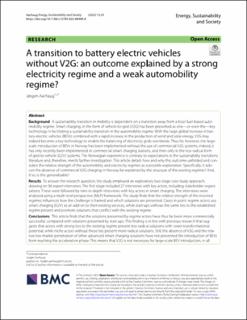| dc.contributor.author | Aarhaug, Jørgen | |
| dc.coverage.spatial | Norway, Oslo | en_US |
| dc.date.accessioned | 2024-01-29T14:58:21Z | |
| dc.date.available | 2024-01-29T14:58:21Z | |
| dc.date.created | 2023-08-15T13:42:47Z | |
| dc.date.issued | 2023-08-15 | |
| dc.identifier.citation | Energy, sustainability and society. 2023, 13 (29), 1-13. | en_US |
| dc.identifier.issn | 2192-0567 | |
| dc.identifier.uri | https://hdl.handle.net/11250/3114376 | |
| dc.description | Aarhaug, J. A transition to battery electric vehicles without V2G: an outcome explained by a strong electricity regime and a weak automobility regime?. Energ Sustain Soc 13, 29 (2023). https://doi.org/10.1186/s13705-023-00409-0 | en_US |
| dc.description.abstract | Background
A sustainability transition in mobility is dependent on a transition away from a fossil fuel-based automobility regime. Smart charging, in the form of vehicle-to-grid (V2G) has been presented as one—or even the—key technology in facilitating a sustainability transition in the automobility regime. With the large global increase in battery electric vehicles (BEVs) combined with a rapid increase in the production of wind and solar energy, V2G may indeed become a key technology to enable the balancing of electricity grids worldwide. Thus far, however, the large-scale introduction of BEVs in Norway has been implemented without the use of commercial V2G systems; indeed, it has only recently been implemented in commercial smart charging stations, and then only in the less-radical form of grid-to-vehicle (G2V) systems. The Norwegian experience is contrary to expectations in the sustainability transitions literature and, therefore, merits further investigation. This article details how and why this outcome unfolded and considers the relative strength of the automobility and electricity regimes as a possible explanation. Specifically, it asks: can the absence of commercial V2G charging in Norway be explained by the structure of the existing regimes? And, if so, is this generalisable?
Results
To answer the research question, the study employed an exploratory two-stage case study approach, drawing on 36 expert interviews. The first stage included 27 interviews with key actors, including stakeholder organisations. These were followed by nine in-depth interviews with key actors in smart charging. The interviews were analysed using a multi-level perspective (MLP) framework. The study finds that the relative strength of the involved regimes influences how the challenge is framed and which solutions are presented. Cases in point: regime actors use smart charging (G2V) as an add-on to their existing services, while start-ups without the same ties to the established regime present and promote solutions that conflict with the existing regime.
Conclusions
This article finds that the solutions presented by regime actors have thus far been more commercially successful, compared with solutions presented by start-ups. This finding is in line with previous research that suggests that actors with strong ties to the existing regime present less-radical solutions with lower transformational potential, while niche actors without these ties present more-radical solutions. Still, the absence of V2G and the relative low market penetration of other advanced smart charging solutions have not prevented the introduction of BEVs from reaching the acceleration phase. This means that V2G is not necessary for large-scale BEV introduction, in all cases. By extension, this suggests that V2G mainly addresses issues with the electrical grid, highlighted by BEVs. BEVs may be successfully introduced at scale, where the pre-existing grid is well-developed, with sufficient balancing capacity. If this precondition is not met, the transition to BEVs may be contingent on smart charging or costly grid extensions. This can be the case at specific locations in Norway, but it may be more prevalent in other locations. | en_US |
| dc.language.iso | eng | en_US |
| dc.rights | Navngivelse 4.0 Internasjonal | * |
| dc.rights.uri | http://creativecommons.org/licenses/by/4.0/deed.no | * |
| dc.title | A transition to battery electric vehicles without V2G: an outcome explained by a strong electricity regime and a weak automobility regime? | en_US |
| dc.title.alternative | A transition to battery electric vehicles without V2G: an outcome explained by a strong electricity regime and a weak automobility regime? | en_US |
| dc.type | Journal article | en_US |
| dc.type | Peer reviewed | en_US |
| dc.rights.holder | © The Author(s) 2023. | en_US |
| dc.description.version | publishedVersion | en_US |
| cristin.ispublished | true | |
| cristin.fulltext | original | |
| cristin.qualitycode | 1 | |
| dc.identifier.doi | 10.1186/s13705-023-00409-0 | |
| dc.identifier.cristin | 2167077 | |
| dc.source.journal | Energy, sustainability and society | en_US |
| dc.source.volume | 13 | en_US |
| dc.source.issue | 29 | en_US |
| dc.source.pagenumber | 1-13 | en_US |
| dc.relation.project | Norges forskningsråd: 283331 | en_US |

